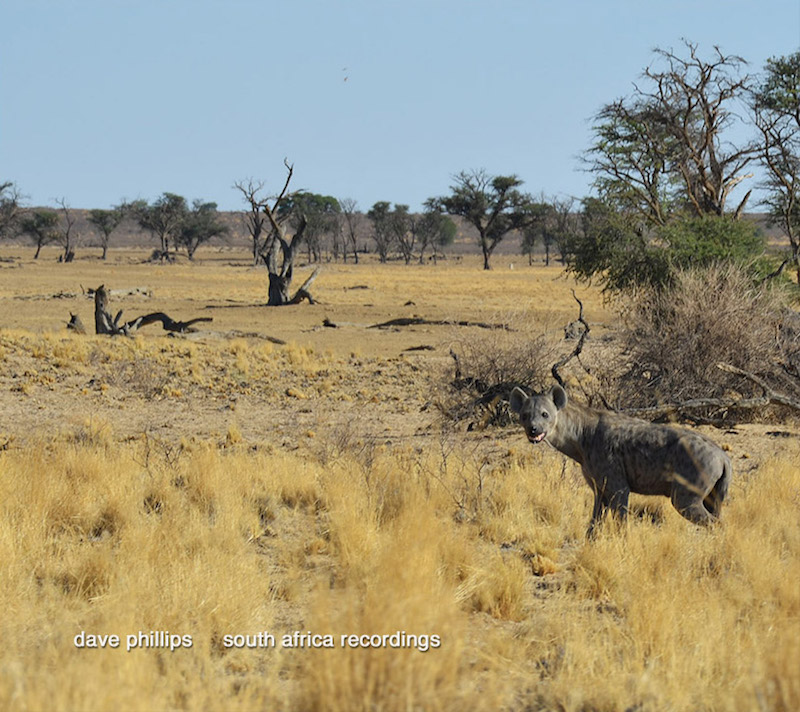
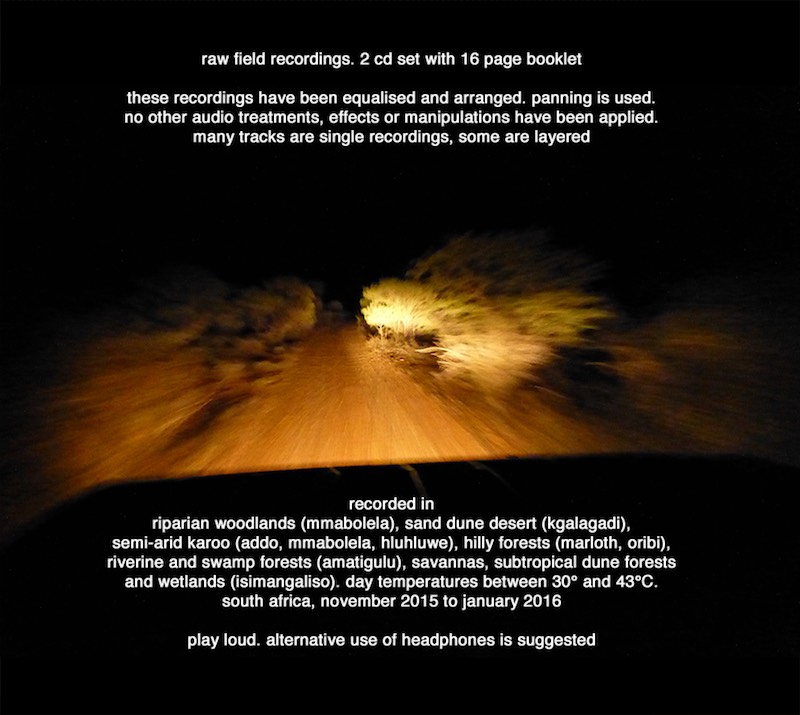
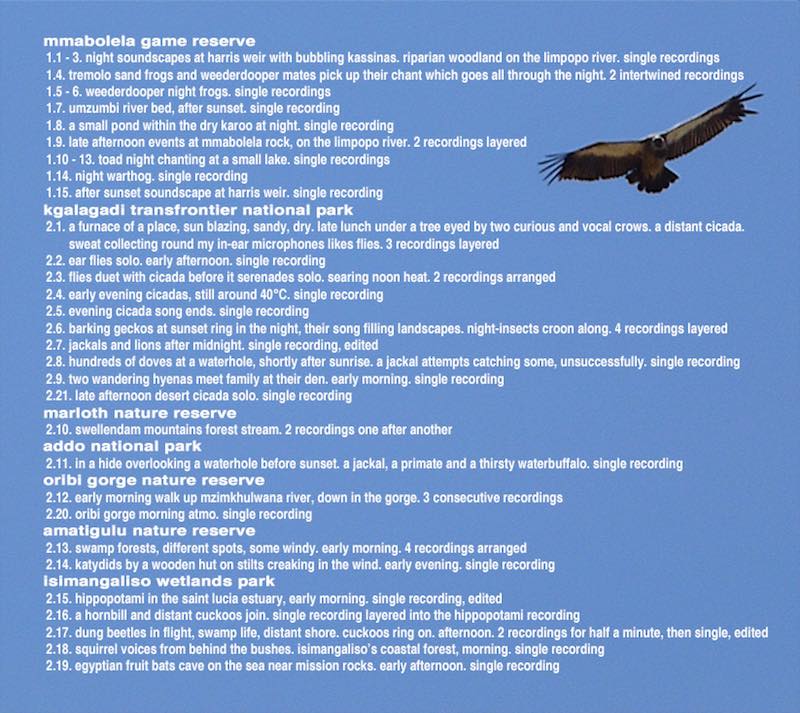
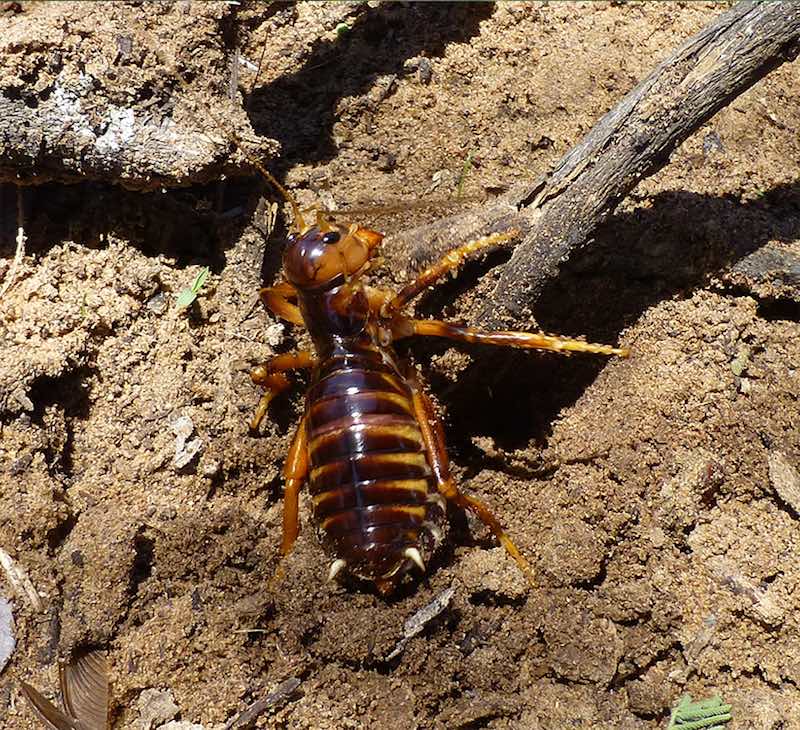
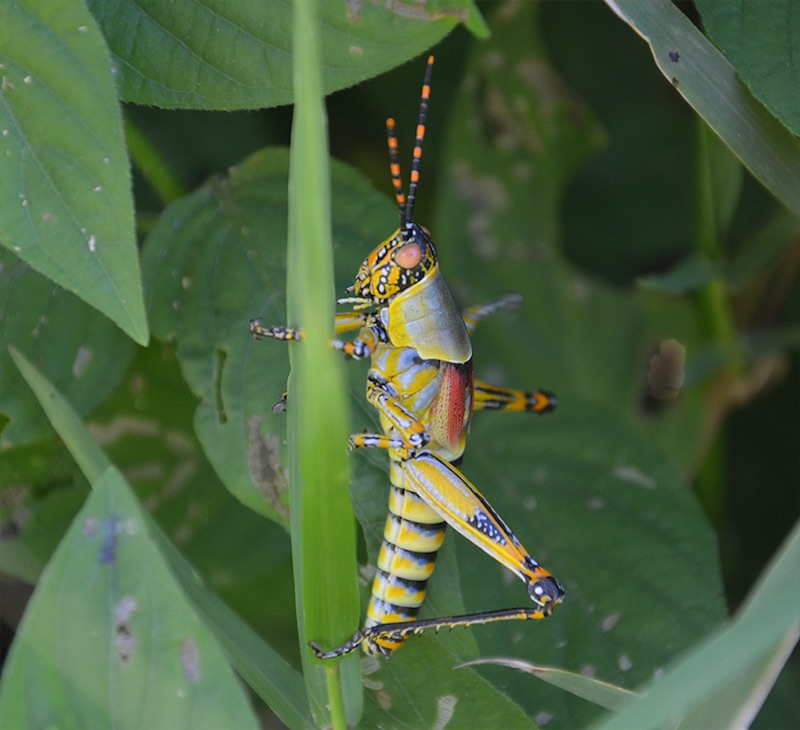
REVIEWS
On imagine les micros de Dave Phillips tout à la fois perdus dans le paysage et affolés par sa faune – celle déjà présente, et celle à supposer, qui devront l’une comme l’autre grouiller, gronder, inonder même le musicien venu recueillir en Afrique du Sud des chants capables de correspondre à ses travaux sonores, voire de le transporter.
S’il est souvent difficile de connaître les conditions dans lesquelles ce genre de collection de « bruits » a été formée et encore davantage d’estimer leurs retouches, l’Homo-Animalis d’hier adresse à son auditeur une liste d’endroits (Addo National Park, Kgalagadi Transfrontier Park…) et d’individus (hyènes, hippopotames, lions, cigales…) et enfin une promesse : les enregistrements sont ici présentés tels quels, certes parfois tressés ou disposés les uns sur les autres.
Alors, le long des deux disques de South Africa Recordings, court presque toujours un grésillement. C’est là l’œuvre que signent des nuées impressionnantes mais capables de se fondre en surface polycarbonate quand elles n’en sont pas empêchées par quelques présences crépitantes, voire claquantes. Un coup de tonnerre, et le regard inspecte le ciel, suit le tracé de marques qu’ont laissé des griffes électriques ou de tranchants battements d’ailes. Les derniers signes donnés par le genre de nature qu’affectionne Dave Phillips.
(Guillaume Belhomme, Le Son du Grisli, December 2017)In 2014, I don’t mind admitting I was quietly terrified of Swiss sound artist Dave Phillips. His album Homo Animalis was bleak, malevolent almost gutteral sound art. It was deeply unsettling, at the time Cyclic Defrost said “This not the kind of soundscape you sink into. Phillips wants you on the edge of your seat, shell-shocked, jumping at shadows.” You can read the full review, a peculiar mixture of fear and admiration, here.
So as you might imagine, when news came of a new Phillips release there was a fair degree of trepidation. What dark caverns of our emotional landscape will he be traversing this time? So it’s with a little bit of relief that I can say that South Africa recordings is just that, the only manipulation is EQ, panning, and some layering of multiple recordings – though not too much he is at pains to point out.
There are a lot of night recordings, possibly because day temperatures varied between 30° and 43°C. We’re talking toads, cicadas, beetles, frogs, geckos, though also warthogs, birds, jackals, lions, hyenas, doves, crows and who knows what else. There are 36 tracks at 157 minutes across two cds.
He doesn’t attempt to isolate individual sounds/ animals like Chris Watson has done in the past, rather these are incredibly vivid soundscapes, the location, the time of day/ night, the interaction between all of the species and their environment, continues to fascinate him.
He’s finding cause and effect, he’s finding composition here, when the thunder crashes and the birds twitter in response, before dying out and the cicadas take over. You couldn’t script it, or sculpt it any better – perhaps this is why Phillips has chosen to leave it pretty much alone. Though I must admit I was a little suspicious of this piece, “Late Afternoon Events at MMabolela Rock on the Impopo river” as it sounds a little too dynamic, and it turns out this is one of his layering experiments, with two recordings.
“Nature speaks languages. We can ”hear” them, but do we listen, do we try to understand?” Asks Phillips in the press release in which he implores the listener to immerse themselves in his sounds. This is very much music if you want it to be, otherwise it’s exotica, the African jungle, a launching pad for your imagination. One thing Phillips does to contribute to his desire for immersion is longevity. Each of the pieces play out over the time and the subtle and not so subtle changes over time are telling. There is a real beauty here, one that Phillips fears will be lost, these remarkable national parks and unique ecosystems at the mercy of mankind. You can listen or you can hear. Phillips has given us the tools, now it’s up to us. You can find it here.
Autoproduit par Dave Phillips, South Africa Recordings regroupe 36 pièces brutes enregistrées entre novembre 2015 et février 2016 dans plusieurs réserves naturelles sud-africaines, présentées sur deux CD. Les animaux et la nature sont souvent très présents dans les enregistrements de DP, on est bien d’accord. Mais ici, leur univers est laissé intact, il ne s’agit pas de composer une fresque psychoacoustique cauchemardesque et angoissante, il s’agit seulement de capter les différents univers sonores composés par la nature, trouver le point de vue idéal et sélectionner l’enregistrement parfait. Pour autant, DP ne verse pas dans l’éthnomusicographie, ni dans l’exotisme, et encore moins dans le documentaire.
C’est brut et réaliste oui, DP enregistre et ne modifie pas ses matériaux, il n’ajoute rien, ne retire rien, au pire il superpose quelques enregistrements parfois, ou les égalisent. De plus, tous les enregistrements (aux durées très variables : de quelques secondes à plus de vingt minutes) se succèdent sans grand souci de cohérence ou de composition, une écoute aléatoire est même “suggérée”. Et pourtant, on est loin d’une recension naturaliste, très loin. Sur ces disques, les enregistrements présentés n’ont pas été réalisé dans un but documentaire. Il ne s’agit pas de capturer le cri typique de telle ou telle espèce, de rendre compte méthodiquement de tel ou tel habitat. Pour DP, l’important semble être de capturer des univers sonores uniques, souvent proches de l’abstraction, parfois même de la musique électronique.
Voici de purs “enregistrements de terrain”, mais qui n’y ressemblent pas vraiment, et c’est ce qui fait leur intérêt. Les captations sonores de DP sont loin des clichés naturalistes ou exotiques, elles nous entraînent dans des paysages sonores intrigants et hors normes, mais qui ne cherchent pas à documenter un “terrain” spécifique (tout en le faisant malgré eux). Ces South Africa recordings ne documentent pas l’univers sonore des réserves sud-africaines, mais la manière dont DP a perçu cet environnement spécifique, elle documente la sensibilité de DP aux sons rudes et nasillards, aux univers abstraits et forts, mais aussi à la beauté sonore que la nature et les animaux ont à offrir. Un disque étonnant et déroutant, beau et immersif toujours, qui change des précédents disques de DP, mais aussi des field recordings habituels.
Then a day later another new Dave Phillips release arrives and it seems like he released this privately himself. It’s a double CD, spanning almost 160 minutes of music and a 16 page booklet of sounds he recorded in South Africa; I assume on one of those organised field recording trips that are a bit beyond my budget (seeing ‘thanks to Pro Helvetia Johannesburg’ perhaps also a bit beyond Phillips’ budget). You get what it says on the package, and that is ‘raw field recordings’ made in the Mmabolela game reserve, Kgalagadi transfrontier national park, Marioth nature reserve, Oribi Gorge nature reserve, Amatigulu nature reserve and Isimangaliso wetland park. There has been some equalisation used on these recordings, as well as panning but otherwise no ‘audio treatments, effects or manipulations have been applied; many tracks are single recordings, some are layered’. All of which has noted on the cover of the release. Now this being a selection of wildlife sounds by Phillips, and if one knows his music, and I do, it is hardly a surprise that this is some very loud music; Phillips likes extreme sounds and nature provides us with as such (‘Nature Is Noise Enough’ was a piece from a long time ago. And it should therefor be no surprise that he recommends the listener to play this loud. If one has ever been to a country with lots of nature and wildlife animals, one can imagine that some of the frequencies from nature are quite ear piercing. I am not sure if Phillips emphasises some of those through equalisation but most of this is truly extreme (and I admit I played this a bit louder, as per the instruction). Lots of animal sounds, frogs, cicadas, hyenas, fruit bats and many more, along with more general sounds from water, ponds and wind sounds. It is all massive in approach and yet there is however also room for more gentle pieces, such as the twenty-two minute at the end of the first, an ‘after sunset soundscape and Harris weir’, with animals and water sounds. Hardly extreme and almost ambient music. Obviously, since this is a release by Phillips there is (not on the package, but on the press release) how much longer this will all exist, in times of global warming, pollution, erosion and whatever tricks mankind is up to. It would be a bad thing if we said ‘oh well, at least we have the recordings for future generations’; let’s hope the real thing will be there for others to hear; so that we are able to hear the same thing as Phillips did; maybe to verify his claim that this is beautiful and that there have been no touching up of sounds.
(Frans De Waard, Vital Weekly, January 2017)South Africa Recordings is a big, generous release, a double-disc set with a 16-page booklet boasting some gorgeous nature photography. It’s a treasure trove for field recording enthusiasts, especially those who prefer their field recordings to be untreated and unadorned. Apart from light layering, this is exactly what it sounds like to visit one of South Africa’s many national parks and nature reserves. The album provides a window into a South Africa that has too often been overshadowed by political and societal clashes; these are the creatures whose lives are affected by national policies, but who care not at all for politicians.
The sound field is thick right from the beginning, with three “night soundscapes with bubbling kassinas.” That’s a frog, by the way, and don’t feel bad, I had to look it up myself. The kassinas, cicadas, crickets, local birds and other unidentifiable citizens of the South African plains provide such a richness of tone that one wonders if any nightclub, no matter how posh, could compete. While listening, one can either attempt to separate the sounds or allow them to cascade over the ears. Phillips recommends listening on headphones, but an immersive stereo system is just as effective, transforming the home into a sonic forest.
Frogs and toads dominate the first disc, calling to mind Yannick Dauby’s Songs of the Frogs of Taiwan. A single representative makes a distinctive tone, but together a chorus is formed. In some locales, the chorus disorients potential predators, who have no idea where their individual prey might be located. But of course ~ as in the aforementioned nightclub ~ mating is on the minds of these slippery citizens, and as the night progresses, they cultivate their calls, hoping for someone to take home. Maybe we’re not so different after all. The center of the first disc includes the type of event that every field recordist dreads and loves at once ~ a thunderstorm near a river. With the right equipment, the event can be captured without risk, which Phillips is able to do here. For minutes at a time, the wildlife is quiet, searching for shelter, although an occasional bird wanders into view, too curious to hide for long.
Visitors to African nations are familiar with the concept of the “big five,” and Phillips is fortunate enough to capture three of them (sonically speaking, of course!). The second disc includes a roaring lion, “laughing hippo”, and “thirsty water buffalo”, but the other two (leopard, elephant) are hardly missed, as there’s plenty of other animal action to be heard. Jackals and hyenas form part of the sonic field of the second disc, and Phillips goes macro on a few smaller creatures. For example, who knew that geckos could “bark”, making a sound like air being let out of a balloon? But the sonic gold here is the sound of hundreds of doves at a waterhole, evading a hungry jackal who just wants breakfast. (It’s easy to think of Hanna-Barbera cartoons, the jackal slack-eared and downtrodden at the end.) From bugs to bats, birds to buffalos, Phillips provides a mosaic of interconnected life, an ecosystem whose every piece is essential for the survival of all. We can be thankful for the parks and preserves, and for Phillips for highlighting their beauty; the next step is to take action to protect such environments, and to reverse the course of encroachment and extinction that threatens to eradicate humanity along with its innocent victims.
(Richard Allen, A Closer Listen, January 2017)Der Filter, der entscheidet, was vom Gehör zur Verarbeitungszentrale weitergeleitet wird, und was nicht, ist unerbittlich in seiner Ausgrenzung. Unzählige kleine Geräusche ziehen täglich an uns vorbei, scheinbar unbemerkt, in jedem Fall unerinnert. Ähnlich dem Unbewussten des Geisteslebens ist auch das ungehört Vorbeiziehende eine wahre Schatzkammer an Klängen oft gerade filigranerer Art. Dave Phillips ist seit langer Zeit ungewöhnlichen Geräuschen auf der Spur. In der Absicht, diese vor dem Verschwinden, dem für immer ungehört bleiben zu entreißen, ist er aber keineswegs nur Archivar. Phillips hat seit jeher eine Leidenschaft für Naturgeräusche, besonders die Klänge von Insekten sprechen ihn ästhetisch an, berühren und überwältigen ihn, wie er in unserem Interview sagte.
Darüber hinaus erkennt er darin aber auch einen „immensen Sprachreichtum, eine immense Kommunikation“ und sieht diese Sprache als „enorm tiefgründig, wenn man ihr richtig zuhören mag“. Man erlernt eine solche Sprache nicht wie eine Fremdsprache, nähert man sich ihr aber intuitiv an, kann dies die Fähigkeiten der Kommunikation, der Wahrnehmung und gerade auch der Empathie enorm erweitern. Als jemand, der seit jeher in seinen künstlerichen Aktionen gegen die Entfremdung zwischen Mensch und Natur ankämpft, ist auch das Sammeln, Aufarbeiten und Vermitteln von seltenen Sounds aus Fauna und Flora ein Teil seiner Arbeit an der Empathie des Menschen für die Natur.
Auf seiner neuesten Doppel-CD präsentiert Phillips eine Vielzahl an primär Tier-Geräuschen, die er im letzten Winter in verschiedenen Provinzen Südafrikas aufgespürt und aufgezeichnet hat, was ihm schon deshalb ein Anliegen war, da viele der Lebensformen auf lange Sicht bedroht sind. Was sich auf den zwei Scheiben findet, ist ein enormes regionales Bestiarium unentdeckter Sounds: von Zikaden flankierte Sandfrösche und ihre Verwandten, die Kassinas aus den waldreicheren Ostprovinzen, deren nahezu perfekt rhythmisches Tremolieren manchmal an Holzblasinstrumente erinnert, dann wieder an Metallteile, die in Hochgeschwindigkeit gegen Glas schlagen; urige Chorgesänge von Kröten, die sich manchmal wie grotesk verfremdete menschliche Stimmen oder zombifiziertes Bellen anhören, und bisweilen wäre es nur ein kleiner Schritt zu minimalem, aber umso kraftstrotzenderem Rhythm Noise; ein gemischter Chor verschiedener Insekten und Amphibien in einem halbtrockenen Flussbett bei Nacht.
Einmal mehr Zikaden, die solo und in Ensembles verschiedener Größe auftreten und deren Serenaden dem, was man auch konventionell Musik nennt, oft recht nah kommen; ein fast niedlich dazwischen quiekendes Warzenschwein; Geckos mit ihrem seltsam ratternden Gebell bei Sonnenuntergang; große Ansammlungen von Tauben, deren Gurren und Flügelschlagen zu einer Kakophonie aus Grunzen und Knarren gerät und immer wieder von anderen, „konventionelleren“ Vogelstimmen durchbrochen wird; dröhnende Insektenschwärme und einzelne Fliegen oder Käfer im Flug; das seltsame Lachen eines Flusspferdes; Löwen, Schakale und Hyänen, deren Jaulen und Brüllen einem undefinierbar erscheint, wenn man sie dabei nicht vor Augen hat; dann Wind und Wasser – der Schauplatz selbst, der ohnehin immer präsent und stets mehr als nur Kulisse ist, macht Amphibien, Insekten und Vögeln für Momente den Platz am vorderen Bühnenrand streitig.
Ungezählte Noise- und Droneplatten könnte man aus diesem Material zusammenschustern, und Alchemisten wie Ô Paradis könnten aus einer Auswahl davon dekonstuierte Popsongs basteln, denn vieles klingt schon in seiner Rohform musikalisch und z.T. sogar überraschend „elektronisch”. Phillips Mission ist eine andere, als Meister des Foregroundings lässt er diesen Pool an ungewöhnlichen und oft undefinierbaren Klängen für sich sprechen. In der Auswahl, aber auch in der subtilen Bearbeitung – räumliches Arrangieren und Einstellen der Aufnahmegeräte, ferner leichtes Equalizing – liefert er die Vorarbeit, an die die Hörer dann mit ihrer Aufmerksamkeit anknüpfen können.
(by Uwe Schneider/, African Paper, December 2016)